

Superman: The never-ending Copyfight Crisis rages on!
Jerry Siegel and Joe Shuster were both about 19 years old when they created the character called “Superman,” in 1933. He was based upon the title character from a novel called Gladiator, by Philip Wylie, Hercules, and Samson. Also, interestingly enough, Siegel and Shuster seem to have swiped the name “Superman” from an ad for “The Man of Bronze,” Doc Savage:
He was not originally appreciated by editors:
But the two did still try to sell Superman and got back nasty replies from some editors. Bell Syndicate told them, “We are in the market only for strips likely to have the most extra-ordinary appeal, and we do not feel Superman gets into this category.” United Features said that Superman was “a rather immature piece of work.”
Finally, in 1938, the pair of impractical dreamers managed to sell the character and an initial 13 page story to Detective Comics, which is now known as just DC. The total value of their first check was $412 and, as it turns out, that supercheck is now up for auction by a company called ComicConnect, which features a suitably purple description:
On March 1, 1938, DC Comics gave two young men from Cleveland $130 for the rights to a comic character named Superman. That $130 check essentially created a billion dollar industry and set in motion nearly 70 years of legal battles that continue to this day. Without this check being written out by DC Comics, there would be no Superman, and thereby no Batman, Wonder Woman, Spider-Man, X-Men, and all the characters that came into existence after the concept of “the superhero” was born with Superman.
Much has been made of the original 1938 $130 payment to Jerome Siegel and Joe Shuster. Did DC Comics take advantage of two eager young men looking for their big break in the comic business, or was this an unequivocally fair business practice between comic book writers and publishers in 1938 America? Whatever you believe, the $130 check is the quintessential symbol of the debate.
No, Superman was not the first superhero to appear in comics. He wasn’t even the first superhero that Siegel and Shuster published. He was the first one to hit, and he hit really, really big. But who’s to say that there wouldn’t have been another, equally as big, perhaps even bigger? Who’s to say that some other genre character might have caught on, and superheroes been an afterthought? Maybe one of the other characters with stories in that first issue of “Action Comics” would have been even more popular, if Superman hadn’t gotten in his way — perhaps the Mandrake the Magician knock-off Zatara would have opened the floodgates to a slew of comic book magicians, and today we’d all be suffering through an era of big-budget Supermagician films? Robert Downey Jr as… Starkoni the Surprising!
Obviously, that is all Earth-2 speculation that doesn’t get anywhere. The point is, on this particular of the infinite earths, Superman was created and Superman opened the floodgates. And his creators received $130 for the character. Here are some images of the check, taken from the ComicConnect auction site:
Please note the ominous notation on the left side of the check:
THIS CHECK IS IN FULL PAYMENT OF THE FOLLOWING ACCOUNT AND THE PAYEE ACCEPTS IT AS SUCH.
NO OTHER RECEIPT REQUIRED.
Today’s contract language is much more thorough, covering all media that now exist or will exist in the future, in perpetuity, but the message behind those words is clear enough.
By signing this check, you acknowledge that we own Superman.
But, there have been complications, as the AP inadvertently notes in their coverage of the auction:
Made out to the duo for $412, the check includes a line item for $130 showing that DC paid for full ownership and rights to the man from Krypton and paved the way for comic books, TV, radio and films. But, a legal dispute over creator’s rights to the character is still far from settled.
Did you catch the error in the paragraph above? If you’re a comic book fan with a sense of history, or if you’ve been following the convolutions of the Superman Copyfight Crisis, you probably did.
The error is this: In that first story, Superman was not from Krypton. In the first panel of Superman’s first story, from the first issue of Action Comics, we learn,
“As a distant planet was destroyed by old age, a scientist placed his infant son within a hastily devised space-ship, launching it toward earth!”
The planet didn’t get the name “Krypton” until the next year, in the first panel of the first issue of “Superman”:
“Just before the doomed planet, Krypton, exploded to fragments, a scientist placed his infant son within an experimental rocket-ship, launching it toward earth!”
See– they were rebooting characters even in the 1930s.
Anyway, if you’ve been following the legal shenanigans swirling around Superman, you know that concepts like the exact date on which the concept of Krypton was created take on fabulous significance. Also, when did his alter ego, Clark Kent, start working for the Daily Planet rather than the Daily Star? When did he move from Cleveland to Metropolis? When did we discover his father on Krypton was called Jor-El? These questions are partly why the heirs of Jerry Siegel were able to recapture only some elements of the character back in 2009:
This means the Siegels — repped by Marc Toberoff of Toberoff & Associates — now control depictions of Superman’s origins from the planet Krypton, his parents Jor-El and Lora, Superman as the infant Kal-El, the launching of the infant Superman into space by his parents as Krypton explodes and his landing on Earth in a fiery crash.
…
In 2008, the same court order ruled on summary judgment that the Siegels had successfully recaptured (as of 1999) Siegel’s copyright in Action Comics No. 1, giving them rights to the Superman character, including his costume, his alter-ego as reporter Clark Kent, the feisty reporter Lois Lane, their jobs at the Daily Planet newspaper working for a gruff editor, and the love triangle among Clark/Superman and Lois.While ownership of the Man of Steel is one point of all this legal activity, the real issue is money and how much Warner Bros. and DC owe the Siegels from profits they collected from Superman since 1999, when the heirs’ recapture of Siegel’s copyright became effective.
DC owns other elements like Superman’s ability to fly, the term kryptonite, the Lex Luthor and Jimmy Olsen characters, Superman’s powers and expanded origins.
That original check was not for “the rights to the man from Krypton.” The Superman that Detective Comics bought in 1938 was not the same Superman that we all know today. That Superman couldn’t fly, for example — he could “leap 1/8th of a mile.” That’s why DC still owns Superman’s ability to fly. It was the Fleischer Brothers studios who first had Superman fly — apparently it looks silly to have an animated man in blue acrobat tights and a red cape “leaping” around all the time.
The whole legal fight is even more complicated and nonsensical than DC’s post-Crisis continuity. In fact, the legal issues are so convoluted that back when DC was fighting with the Siegels over the rights to Superboy they created a distasteful allegory called “Infinite Crisis.” As they were losing that case, they turned Superboy into a villain, canceled his book, and separated him from the rest of the DC Universe. (Lately, apparently, DC has come to some kind of agreement with the Siegels, because Superboy is back, and he’s a clone!)
Now, things are getting more complicated:
In a strategic move in the copyright battle between Warner Bros and the heirs to Superman’s creators, the studio has filed an appeal to reverse earlier rulings in the case and put everything out in open court in a trial.
…
“This case is about the ownership of copyright in the earliest comics that introduced elements of the iconic Superman character and story,” the appeal from Warners lawyer Daniel Petrocelli states. “The case presents an unusually broad array of doctrinal, factual, and procedural issues. But much of the case reduces to a familiar proposition: a deal is a deal.”Warners contends that Laura Siegel Larson, the heir to the Siegel estate, “reneged” on a copyright deal with DC that “guaranteed the family many millions of dollars in cash, royalties, and other compensation.” In its call to have the issue decided by trial, the studio says “the family asserted there was no deal without a long form and the district court agreed, casting aside established California contract law principles — principles essential to the entertainment industry, where many business deals are never formalized.”
So, a deal is a deal, but in the entertainment industry, many business deals are never formalized. Do you understand that? Because I don’t. I admit I have had only very limited experience with this, but I think that in the entertainment industry those “business deals” that aren’t “formalized” consist of you and your buddies sitting at Cantor’s talking about how cool it would be to make a movie with Robert Downey Jr as a Supermagician called Starkoni the Surprising, and he battles this woman who’s sort of a cross between Hugh Hefner and the Wicked Witch of the West, who’s trying to take over the world with her coven of centerfold models.
So, yes, Warner Bros, a deal is a deal, and that’s fair and all. And Mr. Siegel and Mr. Shuster (whose names were misspelled on that check, by the way — that’s why they each had to endorse it twice) signed that NO OTHER RECEIPT REQUIRED check, but. In that case, a deal being a deal and all, can you please explain why it is that you and your corporate entertainment cohort continue to clamor for changes to copyright law? A deal is a deal and all, unless of course we can get the government to come in and change the terms for us. And all the while, DC and Warner Bros — who actually just started publishing a new comic book about the Frankenstein monster, created by Mary Shelley, who had the bad form to create her intellectual property long before it could be protected — have been let’s just call it zealously protecting their “intellectual property.”
But, back to Siegel and Shuster. Mr. Siegel wrote the scripts, and Mr. Shuster did the artwork, for awhile at least. The character became so popular, and was appearing in so many pages per month, including appearing in a daily newspaper strip, that Mr. Shuster employed a stable of artists to help him keep up with demand. Also, sadly, Mr. Shuster’s eyesight began to deteriorate, making it all the more difficult for him to draw.
By 1942, Superman’s creators were in their late 20s, and making more money than they’d ever made before, chronicling Superman’s adventures. Meanwhile, Detective was licensing the hell out of their character. He appeared in a radio show, a series of animated shorts, puzzles, trading cards, dolls, and an official fan club.
Siegel and Shuster would sue National (formerly Detective) Comics in 1946, in an attempt to get back the rights they’d signed away with NO OTHER RECEIPT REQUIRED back in 1938. They’d settle for $94,000.
For how long had they been thinking about suing their publisher? At what point did Superman’s creators start to feel resentment over the fact that while they were doing work for hire on their own character, the publisher was making… well, who knows how much on those Superman trading cards and puzzles?
Siegel himself might have given us an answer, with the help of Shuster’s art studio, in the 14th issue of Superman’s self-titled book. There is an astonishing story in that issue about an unscrupulous businessman who cheats an inventor out of the fruits of his labor, only to be manhandled by Superman. The opening panel gives an overview of the story:
Siegel and Shuster, the “impractical dreamers,” signed that check four years before this story was published, and the fruits of their labors were annexed by Detective/National Comics. So they used their character to get revenge on those unscrupulous schemers, just as they’d used him to get revenge on slumlords, war profiteers, gangsters, and coal mine owners.
Siegel and Shuster’s MarySue is an inventor called Chet Farnsworth, who has created “a powder which would almost instantly extinguish flames.” Clark “Superman” Kent intends to introduce Mr. Farnsworth to an honest businessman who might help him, but the impetuous Farnsworth has already signed with an “unscrupulous schemer” called Jim Baldwin.
Darkly, Clark Kent hopes — for his sake — that he gives Farnsworth a square deal.
But he doesn’t.
These might be the most amazing five panels ever to appear in a mainstream superhero comic book. The creator of the most popular superhero figure in the world is openly protesting the treatment that he and his partner are receiving at the hands of people who own his creation. And he got them to publish this pulp cri de coeur for him.
But, as bleak as things get in this story, Siegel and Shuster’s Superman sets everything right:
Things didn’t work out quite as well for Siegel and Shuster.
Jerry Siegel and his family were broke, their economic status had gotten so bad that Siegels wife Joanne, visited Jack Liebowitz at DC and told them how bad things were. She asked him “Do you really want to see in the newspaper-Creator of Superman Starves to Death?” Jack Liebowitz did not, so DC gave Siegel some writing assignments in 1958. At a price, Jerry would receive no credit or special privileges for his work. But sometime in 1964 Jerry made a comment about wanting to be treated better, and he was immediately fired for it.
In the late 60’s and early 70’s Siegel and Shuster were once again the focus of public attention through comic conventions. They would then go back into court in 1975 for another attempt to sue DC for the rights to Superman. The court decided that the two were not owed any money, but DC did decide to pay the two a “pension” of sorts. They received $35,000 a year for the rest of their lives. Jerry and Joe also got credit for their Superman creation. They got this with the help of then DC Publisher/Editor in Chief Carmine Infantino and many other big name creative people, who persuaded DC to give the creators something. While DC didn’t have to pay anything, it is still a small sum considering the 10’s or possibly 100’s millions that DC made off of Superman in movie, cartoons, comics, and merchandise deals. DC also made Superman related money from copyright infringement lawsuits against other companies, the most famous of these was their out of court settlement with Fawcett Comics.
As we’ve already seen, the legal battles that Mr. Siegel and Mr. Shuster began in the mid-1940s have continued all the way up to today. Superman has remained an iconic character, despite DC’s continued efforts to neuter him. He’s worth hundreds of millions of dollars, and he’s subject to one of the most mind-bendingly convoluted stories ever conceived.
The never-ending Copyfight Crisis!
The panels from Superman issue 14 were scanned from The Superman Chronicles Volume 8, a book that is very much worth your time if you’re at all interested in comic book history in general, Superman in particular.
Latest posts by Ricky Sprague (Posts)
- Meet the start-ups that are thriving in the current economic recovery - May 27, 2016
- How a Wonder Woman comic from 1942 led to the Great California Cow Exodus of 2012, maybe - November 28, 2012
- A common-sense approach to restoring economic prosperity - November 19, 2012
- New Philip K. Dick novel too absurd to be believed - September 17, 2012
- My 90 Days, 90 Reasons submission - September 12, 2012
 Print This Post
Print This Post

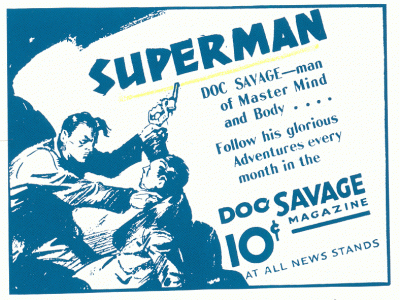
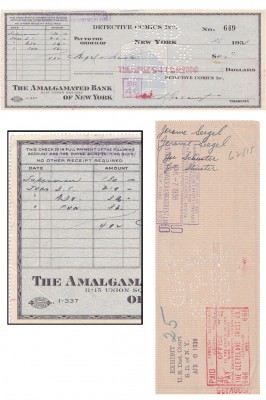
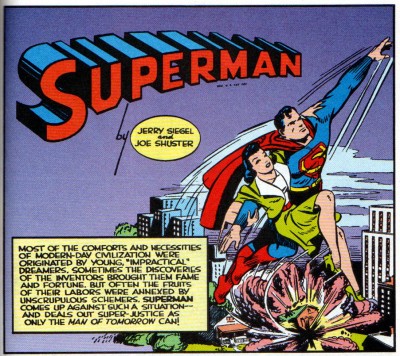
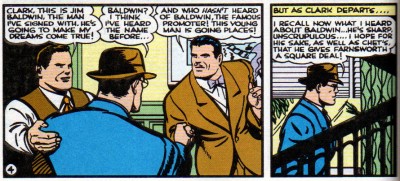
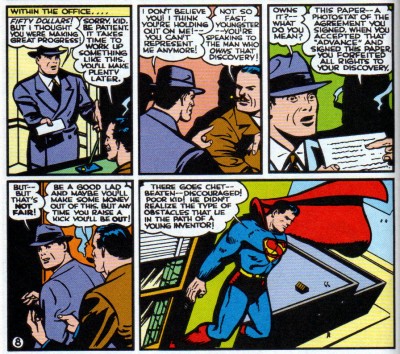




I really enjoy your comics postings.
Me too!
Thanks, I very much appreciate that!
Me three.